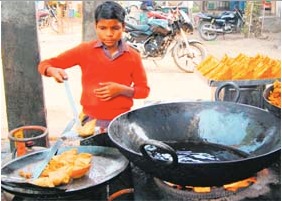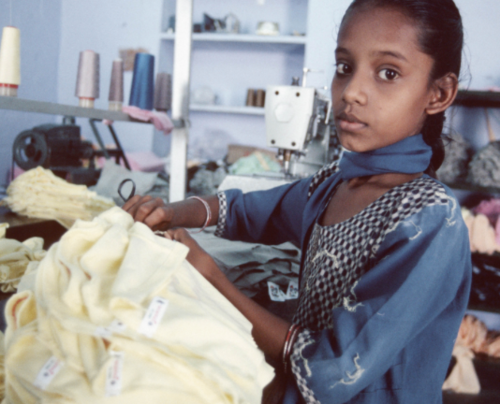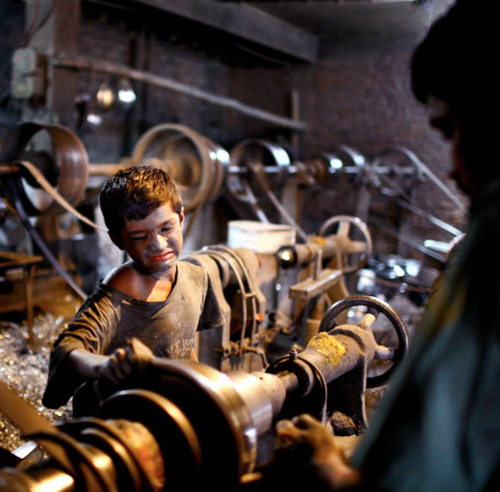CHILD LABOUR
Imagine…
Imagine a childhood where all you see every day is the stone walls of the factory in which you live, the tube lights overhead and the sewing machine at your hands?
Imagine a childhood where the only toys you had were a plough

in your hand or a dirty rag to wash dishes.
Imagine a childhood where you wake up every morning on a factory floor with the smell of machine oil in your nostrils, until you forget even what your mother’s face looked like… This is the story of India’s child labourers. Child labour is a problem in many countries. One agency (ILO, 2009) says that there are over 73 million children the world who work full-time.73 Million is the population of the United Kingdom and Belgium added together! Imagine two whole countries, made up of children under fourteen, all working like slaves; labouring twelve hour days for little or no money. Does that sound like a nightmare? Full-time labour is the every-day reality of one in ten children on earth. About 20 million children in India are working full-time. Why are they not in school? Why don’t they have a normal life?
When parents don’t know…
When the parents have never attended school, they may not understand why their child needs a good school. They may not understand how important it is for their child to have fun and play. Many times parents are offered £400 or more for their child by agents. £400 is a lot of money in India.
Factory directors send ‘agents’ out to poor villages. These agents offer money to parents with a pretty promise in exchange for their children. The children are then pushed into a van at night, and taken to a secret factory location.
Poverty
Some little children are sent into dangerous jobs for money. At home, the bills need to be paid and stomachs need to be fed. And the children land in a trap of slave labour.


School System
The schools in the country-side are just too far, and too crowded. The school books are often boring and out-of-date, and nobody will complain when a child does not attend. When the teachers and the government allow it to happen, it becomes cheap and easy to let the child stay home. A child at home is a child with time to work a job!
Kids? cheap labour!
When you do a paper round, you receive less than the postman! Wherever you go, children get paid less. But a paper round is voluntary. It’s not slavery. Some factory bosses are looking for children. They are happy to pay the parents a good sum. Why is this? Children are cheap to keep. A place on the floor and plate of rice are enough. And children don’t expect much money.
Trapped and alone
How will children stand and stop all this? They feel weak and tired, and they don’t know the laws. Nobody tells them their rights. If they speak up, they are threatened, or beaten.
Survival!
Some children choose to work, especially orphans and street children. They can not afford a school uniform or a school bag. So they brush shoes, wash cars, or work in a restaurant. They think: I would rather be tired than hungry!
*You can read more about street children in the street children chapter.

Where Do Children Work?
SWEET SHOPS.
Indian milk-based sweets are famous and very tasty. People will pay good money for them. These sweets are not made in a factory, but in the sweet shop itself. But do the buyers know who made their favourite sweets?
By two o’clock in the afternoon he finally takes a nap. There is one other boy working beside him. He is 14 years old. And then there is Vikas, his supervisor. At three o’clock Kumar starts his second shift. His day ends after seven, when he has washed all the vessels and prepared them for the next day.Kumar is 11 years old. He works in an Indian sweet shop in Delhi. He lives in the shop‘s kitchen. Every morning he wakes up at 6 and starts his work. He does not stand behind the counter. His job is in a back room: Kumar prepares the sweets which are boiled in big vessels of boiling fat. The room becomes very hot and smelly. Making sweets is a bitter job.

The shop owner stands behind the counter. He keeps his eye on the money and a smile on his face. He tells nobody about the little boy who is making the sweets. One time, two months ago, he had had to beat Kumar. Kumar had fallen asleep during his shift. And still that boy had the courage to ask for a raise? He was already getting 350 rupees (£4) a month! That plus food! And a place to sleep! ‘Who does he think I am?’ the owner had said to himself. ‘Santa Claus?’
At night, Kumar lies looking through a crack in the iron roof. ‘There’s a world out there’, he thinks. ‘A world full of hungry crows and dogs. But at least the dogs are free. Some may have only three legs, but they are free’. Quickly Kumar falls asleep and dreams. In his dream he lives with his mom and dad. And he’s sitting in class with his friends. It’s a beautiful dream. He wakes up by the sound of the rooster. It’s almost six. Vikas is still asleep. Time to get ready!

Silk Industry
‘When will this day end?‘ thinks Maya to herself. She has been twisting threads for hours. It‘s all she ever does. Her head feels dizzy with the smoky fumes that come from the machines. ‘What time is it even? Is it day? Or night? Inside here the eternal night rules. A lamp-lit night’.
Maya is working in a North Indian Silk factory. The windows are blinded, and loud music is playing in the building. In that way, nobody can hear what happens inside. Maya doesn’t hear the music. She looks down. Her hands are bleeding and raw.
One day, four months ago, she woke up in this building. She doesn’t remember what happened. It’s as if she’s always lived here. First she was helping with the looms. She had to dip her hands in boiling water, and handle dead worms. When the infections became too bad, she was put on her new job: twisting threads. Twelve hours a day, seven days a week.
She looks over the endless rows of children in the dark room. Her eyes are searching for Madhuri, her best friend. Her big sister. Madhuri was tied up and beaten very badly 3 months ago. That’s when her and Maya became friends. But Madhuri never talks about what happened. Ever. But then she’s 9nine years old; she’s already big. Maya can not find Madhuri. The air is damp. Her eyelids are drooping.
‘Stay awake! Stupid!’ she scolds herself. If she is not hard on herself, somebody else will be. There’s hours to go!

FACT SHEET:
Indian silk production depends mostly on the labour of child slaves under the age of fourteen. The silk industry is based in the states of Uttar Pradesh, Karnataka and Tamil Nadu
The children that work in India’s sweet shops are from Bihar, Uttar Pradesh and Nepal. These sweet shops can be found all over the country.
Glass blowing units that employ young children can be found in Firozabad, Utter Pradesh. You will also find children working in the Carpet Industry in the same state.
Fire works production is very dangerous because young children have to work with explosives and dangerous chemicals. The biggest fire works factory can be found in Sivakashi, Tamil Nadu, South India. Many children work in cigarette production in the
same state.
Over the years many charities and organizations have come forward to help child labourers. Child slaves need a normal childhood and a chance to go to school. Good Shepherd Homes (GSH) is one of those organisations. GSH gives them a home and an education. They are able to study and play like all children should.
